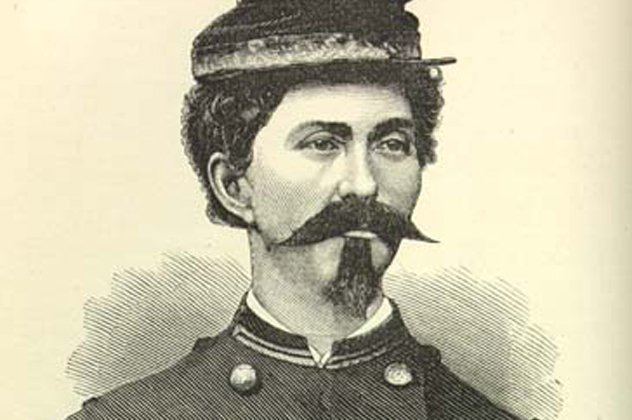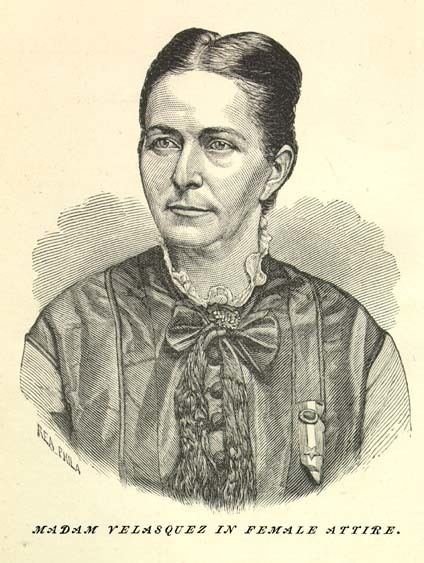Years of service 1861-1865 Died 1897 Role Spy | Name Loreta Velazquez Rank Second Lieutenant Books The woman in battle | |
 | ||
Nickname(s) Lieutenant Harry Buford Battles/wars American Civil WarFirst Battle of Bull RunSiege of Fort DonelsonShiloh People also search for Rose O\'Neal Greenhow, Romi Dias, Isabel Carter | ||
Loreta janeta velazquez
Loreta Janeta Velázquez (June 26, 1842 – 1923), was a Cuban-born woman who masqueraded as a male Confederate soldier during the American Civil War. After her soldier husband's accidental death, she enlisted in the Confederate States Army in 1861. She then fought at Bull Run, Ball's Bluff, and Fort Donelson, but was discharged when her gender was discovered while in New Orleans. Undeterred, she reenlisted and fought at Shiloh, until unmasked once more. She then became a Confederate spy, working in both male and female guises, and as a double agent also reporting to the U.S. Secret Service. She remarried three more times, being widowed in each instance. According to William C Davis, she died in January 1923 under the name Loretta J. Beard after many years away from the public eye in a public psychiatric facility, St. Elizabeths Hospital. She spied on the Union for about 5 years.
Contents
- Loreta janeta velazquez
- Women Civil War Soldiers Educational short
- The Woman in Battle
- Birth and family
- American Civil War
- Travels
- Reception of her book
- Career after the war
- Death
- In popular culture
- Revisionist biography
- References

Women Civil War Soldiers -Educational short
The Woman in Battle
Velázquez recorded her adventures in her 600-page book, The Woman in Battle: A Narrative of the Exploits, Adventures, and travels of Madame Loreta Janeta Velázquez, Otherwise Known as Lieutenant Harry T. Buford, Confederate States Army. The Confederate general Jubal Early refused to accept her memoirs as fact, but recent scholars have verified her claims on the basis of secondary documents, including stories in contemporary newspapers.
Birth and family

Loreta Janeta Velázquez was born in Havana, Cuba, on June 26, 1842, to a wealthy Cuban official and a mother of French and American ancestry. She also used the name Alice Williams. According to her own account, Velázquez was of Castilian descent and related to Cuban governor Diego Velázquez de Cuéllar and artist Diego Velázquez.

Her father was a Spanish government official who owned plantations in Mexico and Cuba. He felt a deep resentment towards the United States after losing an inherited ranch in the Mexican-American War at San Luis Potosi. This animosity perpetuated the estrangement between Velázquez and her father after her elopement with an American soldier.

Velázquez learned the English language at school in New Orleans in 1849, while living with an aunt. Her father's wealth as a plantation owner allowed her this opportunity to travel and continue her education. While in New Orleans, Velázquez took to fairy tales and stories of heroism, citing Joan of Arc as a particular inspiration.

Velázquez was engaged young to Raphael, a Spaniard, in what she referred to in her memoir as a "marriage of convenience." At fourteen years old, she eloped with a Texas United States Army officer known only as William on April 5, 1856 despite the threats to be sent to a convent or back to Cuba from her family. Her decision to elope was poorly received by her family, causing their estrangement. She initially continued to live with her aunt, but after a quarrel with her she moved in with her husband and lived at various army posts, estranging herself further from her family by converting to Methodism.
American Civil War
At the outbreak of the American Civil War, Velázquez's husband resigned his U.S. commission and joined the Confederate Army. The couple became more interested with the stirring Civil War after the early deaths of three of their children. At first, William actually aided Velázquez in her endeavors to cross-dress and to enlist. He agreed to a night out together with Velázquez disguised as a man, assured that upon seeing the behavior of other men she would be dissuaded. Velázquez's desires to enlist, however, were only strengthened. Velázquez failed to convince her husband to let her join him, so she acquired two uniforms, adopted the name Harry T. Buford and moved to Arkansas. There she recruited 236 men in four days, shipped them to Pensacola, Florida, and presented them to her husband as her command. Her husband died soon after in an accident while he was demonstrating the use of weapons to his troops. Velázquez turned her men over to a friend and began to search for more things to do.

Her first experience in combat was as an independent soldier in the First Battle of Bull Run. She eventually grew tired of camp life, however, and again donned female garb to go to Washington, D.C., where she spied for the Confederacy. She claimed to meet Abraham Lincoln and Secretary of War Simon Cameron on this excursion. When she returned to the South, she was assigned to the detective corps. She later left for Tennessee.
In Tennessee, she fought in the siege of Fort Donelson until the surrender. She was wounded in battle, but was not exposed. She fled to New Orleans, where she was arrested, suspected of being a female Union spy in disguise. After she was released, she enlisted to get away from the city.
At Shiloh, she found the battalion she had raised in Arkansas and fought in the battle. As she was burying the dead after a battle, a stray shell wounded her. When the army doctor who examined her discovered she was a woman, she again fled to New Orleans and saw Major General Benjamin F. Butler take command of the city. She gave up her uniform at that point.
Afterwards, in Richmond, Virginia, authorities again hired her as a spy and she began to travel all around the US. At that time, she married a Captain Thomas DeCaulp; he reportedly died soon after in a Chattanooga hospital. (An officer of that name is known to have survived the war.)
She then traveled north where officials hired her to search for herself. In Ohio and Indiana, she tried to organize a rebellion of Confederate prisoners of war.
Travels
After the war, Velázquez traveled in Europe with her brother, as well as throughout South American and the southern United States. She married Major Wasson and emigrated with him to Venezuela. When he died in Caracas, she returned to the United States. During her subsequent travels around the U.S., she gave birth to a baby boy and met Brigham Young in Utah. She arrived in Omaha, almost penniless, but charmed General W. S. Harney into giving her blankets and a revolver. Two days after her arrival in the mining area of Nevada, she received a proposal of marriage from a sixty-year-old man, which she refused. After eventually marrying a younger man, whose name is not known, Velázquez soon left Nevada, travelling with her baby.
Reception of her book
Her book appeared in print in 1876. In the preface, Velázquez stated that she had written the book primarily for money so she could support her child, perhaps to combat the notion of her profiting from the war. The veracity of the account was attacked almost immediately, and remains an issue with scholars. Some claim it is probably entirely fiction, others that the details in the text show a familiarity with the times that would be difficult to completely simulate.
Shortly after its appearance, former Confederate General Jubal Early denounced the book as an obvious fiction.
In 2007, The History Channel aired Full Metal Corset, a program that presented details of Velázquez's story as genuine. However, the overall truthfulness of her account remains indeterminate and highly questionable.
Career after the war
She became very active in public life and politics, and was particularly involved in grand speculative schemes around mining and railway building, as well as being involved in journalism and writing. Her biographer William C. Davis suggests that her actions were generally fraudulent, intending to raise money for herself and associates, although such schemes were typical business practices at that date. Some press accounts were impressed by her vitality and business acumen, such as in a 1891 account from the New York Herald reprinted in the Saturday Evening Mail Terre Haute. Here Velázquez was described as "a woman of business, a woman who can 'run things like a man.'"
Death
Loreta Janeta Velázquez is said to have died in 1897, but historian Richard Hall asserts that the place and date of her death are unknown. Hall, in Patriots in Disguise, takes a hard look at The Woman in Battle and analyzes whether its claims are accurate or fictionalized. Elizabeth Leonard, in All the Daring of the Soldier, assesses The Woman in Battle as largely fiction, but based on real experience. A newspaper report mentions a Lieutenant Bensford arrested when it was disclosed that "he" was actually a woman, and gives her name as Alice Williams, a name which Loreta Velázquez apparently also used.
In popular culture
María Aguí Carter directed Rebel, an investigative documentary, examining the story of Loreta Velázquez. The film is a detective story exploring Velázquez's claims and the politics involved in erasing her from history. It was produced in 2013 and has a run-time of 73 minutes.
Revisionist biography
In October 2016, William C. Davis has published a detailed biography of Velázquez entitled Inventing Loreta Velásquez: Confederate Soldier Impersonator, Media Celebrity, and Con Artist. His account is based on newspaper and archival research which claims that the whole of The Woman in Battle is fiction. Davis asserts that Velázquez was neither Cuban nor a Confederate soldier, but was a thief and a prostitute, possibly born in New York, and eventually a swindler and con artist. Velázquez used many aliases and he is uncertain of her actual name, age, and place of birth, and thus unable to be certain of her family background or ethnicity. The woman he ultiamtely identifies as Velázquez served terms in jail for theft and other minor offenses, and subsequently invented more glamorous origin stories, having learned to lie while working as a prostitute. Davis's work not only views his subject in a negative light, but also expresses doubt whether women ever served effectively as military personnel in the Civil War, his specific doubts around Velázquez's service. This contradicts official records that mention female soldiers as themselves or under male aliases, such as Sarah Rosetta Wakeman. Davis does, however, provide a definite date for her death as Loretta J. Beard on January 26, 1923, at St. Elizabeths Hospital for the Insane, Washington. In his final chapter, Davis critiques feminist and Hispanic historiographical approaches to Velazquez as well as postmodernist literary theory, all of which he says have failed to accurately evaluate Velázquez and have perpetuated her lies to promote their own agenda.
